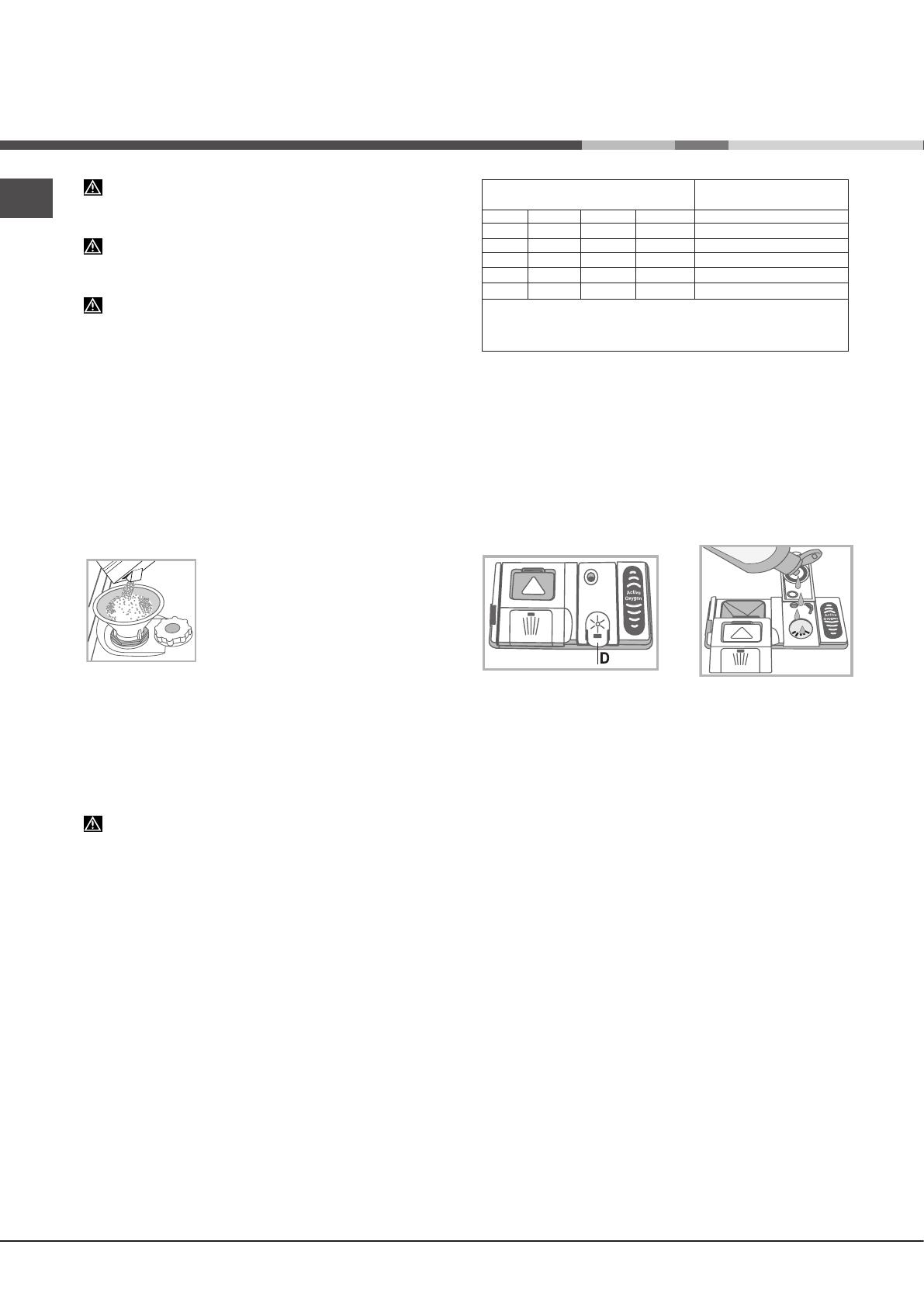
28
Only use products which have been specifically designed
for dishwashers. Do not use table salt or industrial salt.
Follow the instructions given on the packaging.
If you are using a multi-function product, we recommend
that you add salt in any case, especially if the water is hard
or very hard.
(Followtheinstructionsgivenonthepackaging.)
If you do not add salt or rinse aid, the LOW SALT* and
LOW RINSE AID
* indicator lights will remain lit.
Measuring out the refined salt
Theuseof salt prevents the formationofLIMESCALE on the
dishes and on the machine’s functional components.
•Itisimportantthatthesaltdispenserbeneverempty.
•Itisimportanttosetthewaterhardness.
The salt dispenser is located in the lower part of the dishwasher
(seeDescription)
and should be filled:
• WhentheLOWRINSEAIDindicatorlightinthecontrolpanel
is lit *;
• Whenthegreenfloat* on the cap of the salt dispenser is no
longer visible.
• Seeautonomyinthewaterhardnesstable.
1.Removethelowerrackandunscrewthe
containercap(anticlockwise).
2. Only the first time you do this: fill the water
dispenser up to the edge.
3.Positionthe funnel
(see figure)
and
fill the salt container right up to its edge
(approximately1kg);itisnotunusualfora
little water to leak out.
4.Removethefunnelandwipeanysaltresidueawayfromthe
opening; rinse the cap under running water and then screw it on.
It is advisable to perform this procedure every time you add salt
to the container.
Make sure the cap is screwed on tightly, so that no detergent can
getintothecontainerduringthewashcycle(thiscoulddamage
the water softener beyond repair).
Whenever you need to add salt, we recommend carrying out
the procedure before the washing cycle is started.
Setting the water hardness
Forperfect water softener operation, it isessential that the
adjustment be based on the water hardness in your house. Ask
your local water supplier for this information. The factory setting
is for medium water hardness.
SwitchonthedishwasherusingtheON/OFFbutton,pressthe
Settingsbuttonandaccessthemenu“Water hardness” using
thebuttonsnexttothegreyarrows.Thesetlevelappearsonthe
display
(watersoftenersettomediumlevel).
Usethebuttonsnexttothegreyarrowstoselectthedesired
level
(1-2-3-4-5* see Table on water hardness)
uptomaximum
5levels.PresstheOKbuttontosavethesetting.
-Toexitthefunctionwaitafewseconds,presstheESCbutton
orswitchoffthemachineusingtheON/OFFbutton.
Even if using multi-functional tablets, the salt dispenser should
still be filled.
Measuring out the rinse aid
RinseaidmakesdishDRYINGeasier.Therinseaiddispenser
should be filled:
• WhentheLOWRINSEAIDindicatorlightonthepanel/display
is lit *;
• Whenthedarkopticalindicator* on the dispenser door “D”
becomes transparent.
1. Open the dispenser
“D” by pressing and pulling up the tab
on the lid;
2.Carefully introduce the rinseaidas far as the maximum
reference notch of the filling space - avoid spilling it. If this
happens, clean the spill immediately with a dry cloth.
3.Presstheliddownuntilyouhearaclicktocloseit.
NEVER pour the rinse aid directly into the appliance tub.
Rinse-aid dispenser setting
If you are not completely satisfied with the drying results, you
canadjustthequantityofrinseaid.Switchonthedishwasher
usingtheON/OFFbutton,presstheSettingsbuttonandaccess
the menu “Rinse-aid dispenser setting”usingthebuttonsnext
to the grey arrows. The set level appears on the display
(setto
factory level).
Choose the desired level and press the OK button to save the
setting.Toexitthefunctionwaitafewseconds,presstheESC
buttonorswitchoffthemachineusingtheON/OFFbutton.
IftherinseaidlevelissettoZERO,norinseaidwillbesupplied.
TheLOWRINSEAIDindicatorlightwillnotilluminateifyourun
out of rinse aid.
Uptomaximum4levelscanbesetbasedonthedishwasher
model.
• Iftherearestreaksonthecrockery,settheadjustmentdevice
toalowernumber(1-2.)
• If there aredrops of water or limescalemarks, set the
adjustmentdevicetoahighernumber(3-4.)
* Only available in selected models.
Water Hardness Table
Average salt dispenser
capacity duration
**
level °dH °fH mmol/l months
1 0 - 6 0 - 10 0 - 1 7 months
2 6 - 11 11 - 20 1,1 - 2 5 months
3 12 - 17 21 - 30 2,1 - 3 3 months
4 17 - 34 31 - 60 3,1 - 6 2 months
5
*
34 - 50 61 - 90 6,1 - 9 2/3 weeks
For values between 0°f and 10°f, we do not recommend the use of salt.
* a setting of 5 may increase cycle duration.
** 1 wash cycle per day.
(°dH=hardnessmeasuredinGermandegrees-°f=hardness
measuredinFrenchdegrees–mmol/l=millimolesperlitre)
Refined Salt and Rinse Aid
















